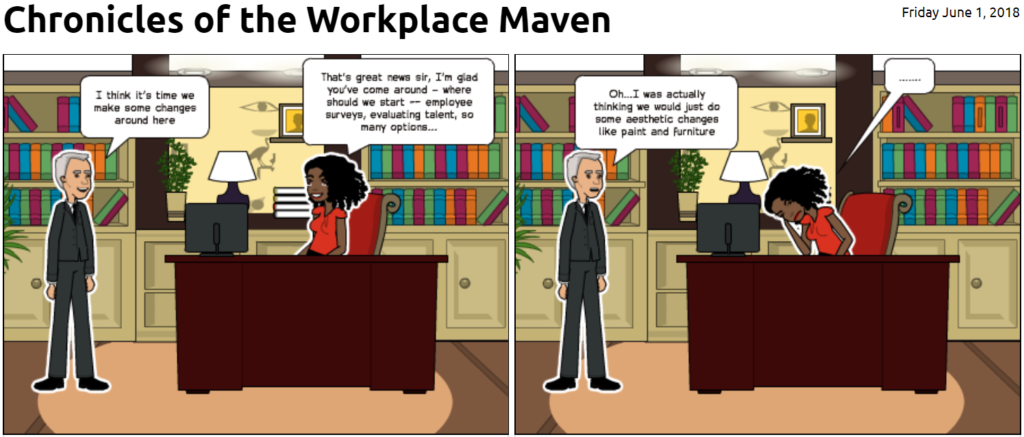Dysfunctional organizational cultures develop for a reason and often reflects the persona of the leadership team. This dysfunction is then reinforced and multiplied through the hiring of others that mirror the toxic behavioral tendencies or through existing employees who succumb to the environment and compromise who they are to fit into the culture. Nonetheless, the good news is that it is still possible to transform even the most dysfunctional of workplace cultures. Doing so is a journey that requires a purposeful strategy and commitment to take the necessary steps to effectuate the change. Here are 5 guiding steps to transforming your culture.
1. Acknowledge Current State
Before an organization can transform its culture, its leadership must first recognize the current dysfunctional state of the environment and identify what factors contribute to it. There can sometimes be a disconnect between what leaders believe the culture is in their organization and what the culture actually is that is lived by their employees on a day to day basis. Often this realization will only occur in response to an impactful event that has negatively affected the bottom line or sustainability of an organization such as a significant loss in business, threat of bankruptcy or a major public relations disaster. However it occurs, leaders have a responsibility to be aware of the current culture that’s been created around them. And it is only when the leadership in an organization realizes and recognizes that their current culture needs to be transformed to support its employees and ultimately the organization’s success and progress, can cultural change begin to occur.
2. Develop a Strategy & Vision
Once you understand your current organizational culture and establish the need for altering it, the next step is to define the organization’s strategic direction and determine what a healthy culture in support of this vision looks like. Ask yourself, what are the values you’d like to see represented in you organizational culture? You can’t transform the culture if you don’t know what aspects of it need to be changed and where your organization wants to be. Once you find your way to those answers you must create the plan to ensure that the desired culture becomes a reality. Simply knowing what needs to be transformed isn’t enough – you need to lay out the strategy of what needs to happen to get you there.
3. Examine Current Players
This is one of the hardest steps in culture change. Although you’ve made the decision to transform the culture and move away from the dysfunction, people at all levels must now unlearn the old values and behaviors before they can begin to learn the new ones. Everyone, especially those in leadership positions, must decide to change their current behavior in order to create the desired culture. Remember, the leadership team is pivotal in prompting cultural transformation, but it has to so by more than lip service of what you want the culture to be – it must be shown through behavior and sometimes you will find that those in leadership positions are the very people who are not capable of nor have the desire to modify their behaviors into more positive ones that fit the new anticipated culture. Ask yourself, does your current leadership team fit that new vision? If the answer is no, then the change must first begin by removing those that cannot back the new vision who will inevitably impede your progress and instead add new leaders who will be capable of modeling and supporting the change.
4. Communicate the Vision
Communication is the most important element in change strategy. Clearly communicating the vision so that employees can gain a clear understanding of the organization’s vision; what the new desired culture looks like; and where, as employees they fit within all of it is key to successfully transforming the culture. Explain what your new desired culture is and why it matters to them and to the success of the organization. Everyone must clearly understand what is expected of them and what new behaviors in support of this transformed culture looks like if the transformation is to be successful. Training can be a very useful tool in teaching these new behaviors, but leading by example is going to be the best way to educate employees on these new expectations.
5. Empower Others
In order to be successful in your journey of transforming the culture, you will need to identify the change champions who will carry forward the momentum of your organizational change. This group of formal and informal leaders will be enthusiastic and readily embrace the change and will actively engage in promoting the change as positive. Encourage them to align their work and leadership styles so they can keep demonstrating what it looks like to live the culture. Most importantly, make sure you recognize your change agents for their contributions so they know they are being regarded for upholding the culture and are motivated to continue to drive your new culture forward.
Changing an organization’s culture is one of the most difficult leadership challenges. Ultimately, culture change depends on behavior change which often requires people changes – including changes within the leadership team. But if an organization is really ready to change its culture, it will need to prioritize doing so and dedicate the time and commitment to properly plan and execute their cultural transformation.

